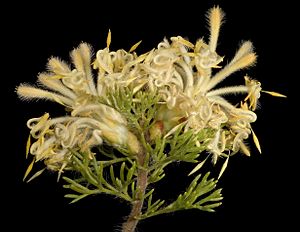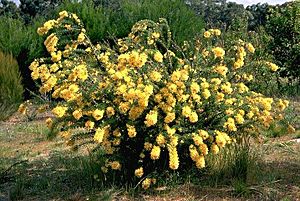Petrophile serruriae facts for kids
Quick facts for kids Petrophile serruriae |
|
|---|---|
 |
|
| Scientific classification | |
| Genus: |
Petrophile
|
| Species: |
serruriae
|
| Synonyms | |
|
|
The Petrophile serruriae is a unique flowering plant. It belongs to the Proteaceae family, which includes many beautiful Australian plants. This plant is a type of shrub that grows only in the southwestern part of Western Australia. This means it is endemic to that area.
It has many leaves that grow close together. These leaves are shaped like needles and have sharp points. The plant also produces lovely oval-shaped flowers. These flowers are covered in soft, silky hairs and can be yellow, greyish-mauve, or pink.
Contents
What Does Petrophile serruriae Look Like?
The Petrophile serruriae is a shrub that can grow upright or spread out. It usually reaches a height of about 0.2 to 1.5 meters (that's about 8 inches to 5 feet). Its small branches and leaves are covered in silky hairs. Unlike some plants, it does not have a special woody base called a lignotuber.
Leaves and Flowers
The leaves of this plant are quite special. They are called bipinnate or tripinnate, which means they are divided into many smaller parts. Each leaf is about 15 to 34 millimeters long (around 0.6 to 1.3 inches). They grow on a small stalk called a petiole, which is 2 to 10 millimeters long. Each leaf has many needle-shaped, sharply-pointed sections, usually between 27 and 35 of them!
The flowers grow in oval-shaped heads, about 10 millimeters (0.4 inches) across. These flower heads appear at the ends of the branches and where the leaves meet the stem. There are a few small, leaf-like structures called bracts at the base of the flower heads, but these fall off easily. The flowers themselves are 13 to 16 millimeters long (about 0.5 to 0.6 inches). They are silky-hairy and come in shades of yellow, greyish-mauve, or pink.
When Does It Flower and What About Its Fruit?
Petrophile serruriae mostly flowers from July to December. After flowering, it produces a type of fruit called a nut. These nuts are joined together in an oval or round head. This fruit head is about 10 to 12 millimeters (0.4 to 0.5 inches) wide.
How Was Petrophile serruriae Named?
The Petrophile serruriae was first officially described in 1830. A famous botanist named Robert Brown (botanist, born 1773) gave it its formal name. He wrote about it in a book called Supplementum. The plant material he studied was collected by William Baxter in 1823. Baxter found it near a place called King George Sound.
Meaning of the Name
The second part of the plant's name, serruriae, means "like a plant in the genus Serruria". This suggests that Robert Brown thought it looked similar to plants in that group.
Where Does Petrophile serruriae Grow?
This petrophile plant is quite common in areas with coastal limestone. It grows widely across the southwest of Western Australia. You can find it from near Geraldton all the way down to near Albany.
Is Petrophile serruriae Endangered?
Good news! The Western Australian Government's Department of Parks and Wildlife has classified this plant as "not threatened." This means it is not currently at risk of disappearing.


